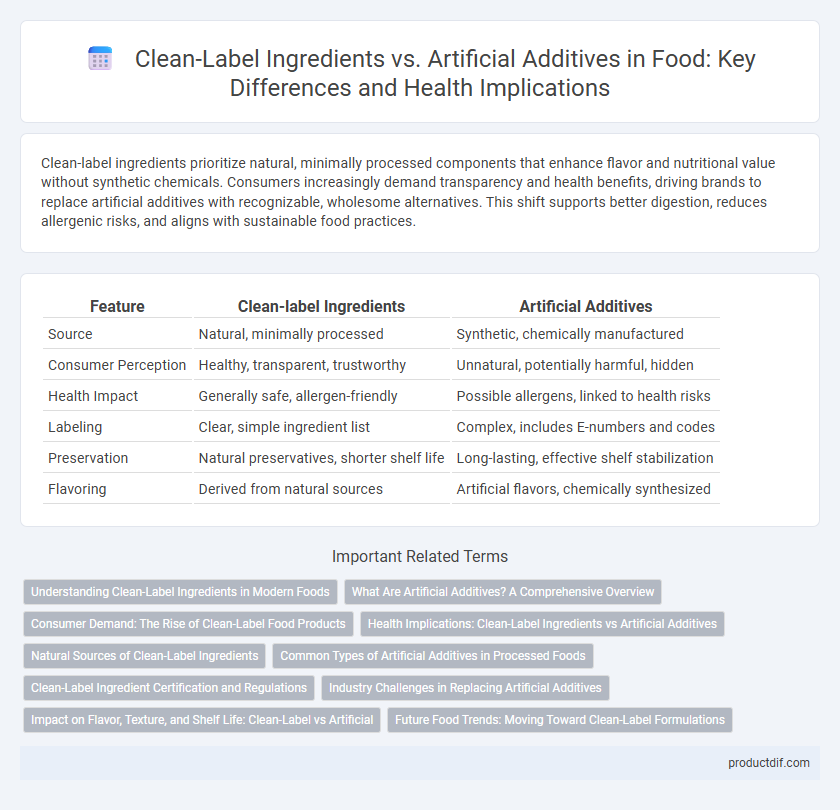Clean-label ingredients prioritize natural, minimally processed components that enhance flavor and nutritional value without synthetic chemicals. Consumers increasingly demand transparency and health benefits, driving brands to replace artificial additives with recognizable, wholesome alternatives. This shift supports better digestion, reduces allergenic risks, and aligns with sustainable food practices.
Table of Comparison
| Feature | Clean-label Ingredients | Artificial Additives |
|---|---|---|
| Source | Natural, minimally processed | Synthetic, chemically manufactured |
| Consumer Perception | Healthy, transparent, trustworthy | Unnatural, potentially harmful, hidden |
| Health Impact | Generally safe, allergen-friendly | Possible allergens, linked to health risks |
| Labeling | Clear, simple ingredient list | Complex, includes E-numbers and codes |
| Preservation | Natural preservatives, shorter shelf life | Long-lasting, effective shelf stabilization |
| Flavoring | Derived from natural sources | Artificial flavors, chemically synthesized |
Understanding Clean-Label Ingredients in Modern Foods
Clean-label ingredients are natural, minimally processed components that consumers recognize and trust, promoting transparency in food products. These ingredients often exclude artificial additives, preservatives, and synthetic chemicals, aligning with the growing demand for healthier and more natural food options. Understanding the benefits and sourcing of clean-label ingredients helps food manufacturers meet consumer expectations while maintaining product quality and safety.
What Are Artificial Additives? A Comprehensive Overview
Artificial additives are synthetic substances added to food products to enhance flavor, appearance, texture, or shelf life. Common types include preservatives like sodium benzoate, flavor enhancers such as monosodium glutamate (MSG), and artificial colors like Red 40. These additives undergo regulatory evaluation but often face consumer scrutiny due to potential health concerns and demand for cleaner, more natural labels.
Consumer Demand: The Rise of Clean-Label Food Products
Consumer demand for clean-label food products has surged as shoppers prioritize transparency and natural ingredients over artificial additives. Studies reveal that 70% of consumers prefer products with recognizable, minimally processed components, driving manufacturers to replace synthetic preservatives and colors with plant-based alternatives. This shift reflects broader health consciousness and a desire for foods perceived as safer and more environmentally friendly.
Health Implications: Clean-Label Ingredients vs Artificial Additives
Clean-label ingredients, typically derived from natural sources, contribute to improved health outcomes by reducing exposure to synthetic chemicals and potential allergens found in artificial additives. Research links artificial additives to adverse effects such as hyperactivity, allergic reactions, and long-term chronic conditions, emphasizing the importance of ingredient transparency. Emphasizing clean-label products supports consumer demand for safer, minimally processed foods that align with health-conscious lifestyles.
Natural Sources of Clean-Label Ingredients
Clean-label ingredients sourced from fruits, vegetables, herbs, and spices provide natural antioxidants, colorants, and preservatives that enhance food quality and safety without synthetic chemicals. Ingredients like turmeric, beetroot powder, and rosemary extract are increasingly favored for their health benefits and consumer-friendly labeling. Utilizing natural sources supports sustainability and aligns with growing demand for transparent ingredient lists in the food industry.
Common Types of Artificial Additives in Processed Foods
Common types of artificial additives in processed foods include preservatives such as sodium benzoate and potassium sorbate, which extend shelf life by inhibiting microbial growth. Flavor enhancers like monosodium glutamate (MSG) intensify taste profiles, while artificial colors including tartrazine and Allura Red provide visual appeal. Emulsifiers such as lecithin and polysorbates improve texture and consistency, but many consumers seek clean-label ingredients to avoid these synthetic compounds.
Clean-Label Ingredient Certification and Regulations
Clean-label ingredient certification emphasizes transparency, natural sourcing, and minimal processing, aligning with consumer demand for health-conscious and environmentally friendly foods. Regulatory bodies such as the FDA in the United States and EFSA in Europe impose strict guidelines to ensure clean-label claims are substantiated, preventing misleading marketing and protecting public health. Certification programs like Non-GMO Project Verified and Organic USDA Certified provide standardized frameworks for verifying ingredient authenticity and compliance with clean-label standards.
Industry Challenges in Replacing Artificial Additives
Replacing artificial additives in the food industry poses significant challenges, including maintaining product shelf life, taste, and texture while using clean-label ingredients. Clean-label components often have variability in sourcing and stability, requiring reformulation and rigorous testing to meet regulatory standards and consumer expectations. Balancing cost-effectiveness and scalability remains a critical hurdle as manufacturers strive for transparency and natural solutions.
Impact on Flavor, Texture, and Shelf Life: Clean-Label vs Artificial
Clean-label ingredients offer a more natural flavor and texture, often enhancing the authentic taste of food products without the chemical aftertaste associated with artificial additives. While artificial additives can extend shelf life significantly and maintain consistent texture, they may compromise flavor quality and pose health concerns. Choosing clean-label ingredients supports transparency and consumer trust but may require innovative preservation techniques to balance shelf life and sensory appeal.
Future Food Trends: Moving Toward Clean-Label Formulations
Clean-label ingredients prioritize transparency, natural origin, and minimal processing, responding to consumer demand for healthier and safer food options. Artificial additives, often linked to health concerns and regulatory scrutiny, are gradually being replaced in formulations by plant-based extracts, natural preservatives, and minimally processed components. Future food trends indicate a widespread industry shift toward clean-label formulations to enhance product appeal, sustainability, and nutritional value.
Clean-label ingredients vs Artificial additives Infographic

 productdif.com
productdif.com